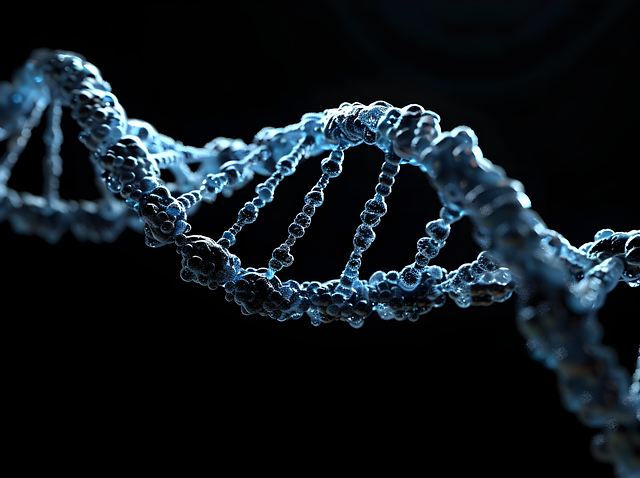NAD+ for cellular repair is a promising anti-aging strategy. As a coenzyme, NAD+ stabilizes DNA breaks, activates repair proteins, facilitates apoptosis, and boosts sirtuin activity to rejuvenate cells and maintain genomic integrity. Declining NAD+ levels with age contribute to cellular health issues, making NAD+ therapy a potential treatment for age-related diseases and conditions linked to DNA damage. Further research is needed to expand knowledge of NAD+'s role in cellular healing and develop targeted therapies for personalized medicine approaches centered around cellular repair.
“Unraveling the Power of NAD+ for Cellular Repair: A Comprehensive Guide
This article delves into the intriguing world of NAD+ therapy, a promising approach in supporting DNA repair and fostering cellular regeneration. NAD+, or nicotinamide adenine dinucleotide, is a crucial coenzyme that plays a pivotal role in cell metabolism. By exploring its impact on DNA repair mechanisms and its potential to stimulate cellular renewal, we uncover how NAD+ therapy offers a novel perspective in healthcare. From understanding its fundamental functions to its therapeutic applications, this guide provides an insightful journey through the science behind NAD+ for cellular repair.”
Understanding NAD+ and Its Role in Cells
NAD+, or Nicotinamide adenine dinucleotide, is a coenzyme found in all living cells, playing a crucial role in various metabolic processes. It acts as an essential catalyst for cellular respiration, helping convert food into energy that fuels our bodies. Beyond its energy-related functions, NAD+ is increasingly recognized for its vital role in DNA repair and cellular regeneration. As we age, the levels of NAD+ in our cells naturally decline, leading to a cascade of negative effects on cellular health and function.
In terms of NAD+ for cellular repair, this coenzyme is directly involved in several key pathways that maintain genomic stability. It facilitates the repair of damaged DNA by helping to stabilize double-stranded breaks and promoting the activation of proteins essential for repair mechanisms. Furthermore, NAD+ supports the elimination of dysfunctional cells through a process called programmed cell death (apoptosis), allowing for the regeneration of new, healthy cells. By enhancing these critical cellular processes, NAD+ therapy holds promise as a potential anti-aging intervention and a means to support overall genomic health.
The Impact of NAD+ on DNA Repair Mechanisms
NAD+, or nicotinamide adenine dinucleotide, plays a pivotal role in DNA repair mechanisms within our cells. As a key coenzyme, it acts as a crucial facilitator for numerous cellular processes essential to maintaining genetic integrity. By enhancing the activity of sirtuins—a class of proteins involved in DNA repair and genomic stability—NAD+ boosts the body’s natural ability to identify and correct damaged DNA strands.
This process is particularly significant given the constant exposure of our cells to environmental stressors, which can cause DNA damage. Sufficient NAD+ levels ensure that our cells have the necessary tools to navigate and counteract this damage, fostering efficient cellular regeneration and promoting overall genomic health. Thus, NAD+ for cellular repair isn’t just a trend; it’s a vital component in supporting our body’s natural defense mechanisms against the wear and tear of daily life.
Cellular Regeneration: NAD+'s Powerful Effect
Cellular regeneration is a remarkable process, and at its heart lies nicotinamide adenine dinucleotide (NAD+), a coenzyme crucial for DNA repair and overall cellular health. NAD+ acts as a powerful catalyst, facilitating the body’s natural repair mechanisms by enhancing the activity of sirtuins—a class of proteins known for their role in maintaining genomic stability. This enzymatic interaction initiates a cascade of events that promote cell rejuvenation and DNA restoration.
When cellular damage occurs due to environmental stressors or age-related wear, NAD+ steps in as a reparative force. It boosts the body’s ability to fix damaged DNA strands, prevent cellular decay, and encourage regrowth. By supporting sirtuins in their mission to maintain genomic integrity, NAD+ for cellular repair becomes an effective strategy to counteract the natural decline associated with aging and exposure to harmful factors, ultimately fostering a robust and rejuvenated cellular landscape.
Therapeutic Applications and Future Research
NAD+ therapy has shown promising therapeutic applications in various fields, particularly in supporting DNA repair and promoting cellular regeneration. This innovative approach offers a potential game-changer in managing age-related diseases and conditions associated with DNA damage. By enhancing NAD+ levels, cells can improve their ability to fix mutations and maintain genomic stability.
Future research should explore the full extent of NAD+’s role in cellular healing processes. Further clinical trials could provide valuable insights into its effectiveness in different populations and disease states. Understanding the underlying mechanisms will contribute to developing targeted therapies, opening up exciting possibilities for personalized medicine focused on NAD+ for cellular repair.
NAD+ therapy emerges as a promising frontier in cellular repair, harnessing the power of this coenzyme to enhance DNA repair mechanisms and stimulate cellular regeneration. By understanding the intricate roles of NAD+ within cells, we uncover its potential to revolutionize therapeutic approaches, offering new hope for various health conditions. Further research into NAD+ for cellular repair is essential to unlocking its full potential and developing effective treatments that may transform our understanding and management of disease.
